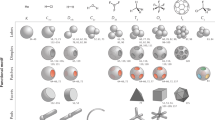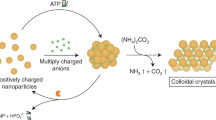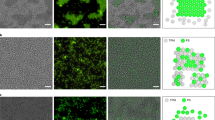Abstract
From rock salt to nanoparticle superlattices, complex structure can emerge from simple building blocks that attract each other through Coulombic forces1,2,3,4. On the micrometre scale, however, colloids in water defy the intuitively simple idea of forming crystals from oppositely charged partners, instead forming non-equilibrium structures such as clusters and gels5,6,7. Although various systems have been engineered to grow binary crystals8,9,10,11, native surface charge in aqueous conditions has not been used to assemble crystalline materials. Here we form ionic colloidal crystals in water through an approach that we refer to as polymer-attenuated Coulombic self-assembly. The key to crystallization is the use of a neutral polymer to keep particles separated by well defined distances, allowing us to tune the attractive overlap of electrical double layers, directing particles to disperse, crystallize or become permanently fixed on demand. The nucleation and growth of macroscopic single crystals is demonstrated by using the Debye screening length to fine-tune assembly. Using a variety of colloidal particles and commercial polymers, ionic colloidal crystals isostructural to caesium chloride, sodium chloride, aluminium diboride and K4C60 are selected according to particle size ratios. Once fixed by simply diluting out solution salts, crystals are pulled out of the water for further manipulation, demonstrating an accurate translation from solution-phase assembly to dried solid structures. In contrast to other assembly approaches, in which particles must be carefully engineered to encode binding information12,13,14,15,16,17,18, polymer-attenuated Coulombic self-assembly enables conventional colloids to be used as model colloidal ions, primed for crystallization.
This is a preview of subscription content, access via your institution
Access options
Access Nature and 54 other Nature Portfolio journals
Get Nature+, our best-value online-access subscription
$29.99 / 30 days
cancel any time
Subscribe to this journal
Receive 51 print issues and online access
$199.00 per year
only $3.90 per issue
Buy this article
- Purchase on Springer Link
- Instant access to full article PDF
Prices may be subject to local taxes which are calculated during checkout




Similar content being viewed by others
Data availability
The data that support the findings of this study are available from the corresponding author on request.
References
Pauling, L. The principles determining the structure of complex ionic crystals. J. Am. Chem. Soc. 51, 1010–1026 (1929).
Shevchenko, E. V. et al. Structural diversity in binary nanoparticle superlattices. Nature 439, 55–59 (2006).
Kalsin, A. M. et al. Electrostatic self-assembly of binary nanoparticle crystals with a diamond-like lattice. Science 312, 420–424 (2006).
Grzybowski, B. A. et al. Electrostatic self-assembly of macroscopic crystals using contact electrification. Nat. Mater. 2, 241–245 (2003).
Go, D. et al. Programmable co-assembly of oppositely charged microgels. Soft Matter 10, 8060–8065 (2014).
Månsson, L. K. et al. Preparation of colloidal molecules with temperature-tunable interactions from oppositely charged microgel spheres. Soft Matter 15, 8512–8524 (2019).
Mihut, A. M. et al. Assembling oppositely charged lock and key responsive colloids: a mesoscale analog of adaptive chemistry. Sci. Adv. 3, e1700321 (2017).
Wang, Y. et al. Crystallization of DNA-coated colloids. Nat. Commun. 6, 7253 (2015).
Leunissen, M. E. et al. Ionic colloidal crystals of oppositely charged particles. Nature 437, 235–240 (2005).
Bartlett, P. & Campbell, A. I. Three-dimensional binary superlattices of oppositely charged colloids. Phys. Rev. Lett. 95, 128302 (2005).
Bartlett, P., Ottewill, R. H. & Pusey, P. N. Superlattice formation in binary-mixtures of hard-sphere colloids. Phys. Rev. Lett. 68, 3801–3804 (1992).
Pusey, P. N. & Vanmegen, W. Phase-behavior of concentrated suspensions of nearly hard colloidal spheres. Nature 320, 340–342 (1986).
Sacanna, S. et al. Lock and key colloids. Nature 464, 575–578 (2010).
de Nijs, B. et al. Entropy-driven formation of large icosahedral colloidal clusters by spherical confinement. Nat. Mater. 14, 56–60 (2015).
Harper, E. S., van Anders, G. & Glotzer, S. C. The entropic bond in colloidal crystals. Proc. Natl Acad. Sci. USA 116, 16703–16710 (2019).
Nykypanchuk, D. et al. DNA-guided crystallization of colloidal nanoparticles. Nature 451, 549–552 (2008).
Wang, Y. F. et al. Patchy particle self-assembly via metal coordination. J. Am. Chem. Soc. 135, 14064–14067 (2013).
Rogers, W. B., Shih, W. M. & Manoharan, V. N. Using DNA to program the self-assembly of colloidal nanoparticles and microparticles. Nat. Rev. Mater. 1, 16008 (2016).
Hunter, R. J. Foundations of Colloid Science 2nd edn (Oxford Univ. Press, 2001).
Milner, S. T., Witten, T. A. & Cates, M. E. Theory of the grafted polymer brush. Macromolecules 21, 2610–2619 (1988).
Vutukuri, H. R. et al. Bonding assembled colloids without loss of colloidal stability. Adv. Mater. 24, 412–416 (2012).
McGinley, J. T. et al. Crystal-templated colloidal clusters exhibit directional DNA interactions. ACS Nano 9, 10817–10825 (2015).
Seo, S. E. et al. Non-equilibrium anisotropic colloidal single crystal growth with DNA. Nat. Commun. 9, 4558 (2018).
Alexander, S. Polymer adsorption on small spheres—scaling approach. J. Phys. (Paris) 38, 977–981 (1977).
Gennes, P. G. D. Stabilité de films polymère/solvant. C. R. Acad. Sci. II 300, 839–843 (1985).
Kleshchanok, D., Tuinier, R. & Lang, P. R. Direct measurements of polymer-induced forces. J. Phys. Condens. Matter 20, 073101 (2008).
Barnes, T. J. & Prestidge, C. A. PEO–PPO–PEO block copolymers at the emulsion droplet–water interface. Langmuir 16, 4116–4121 (2000).
Stenkamp, V. S. & Berg, J. C. The role of long tails in steric stabilization and hydrodynamic layer thickness. Langmuir 13, 3827–3832 (1997).
Kim, A. J., Manoharan, V. N. & Crocker, J. C. Swelling-based method for preparing stable, functionalized polymer colloids. J. Am. Chem. Soc. 127, 1592–1593 (2005).
Glaser, J. et al. Strong scaling of general-purpose molecular dynamics simulations on GPUs. Comput. Phys. Commun. 192, 97–107 (2015).
Acknowledgements
This work was supported primarily by the NSF CAREER award DMR-1653465. We are grateful for shared facilities provided through the Materials Research Science and Engineering Center (MRSEC) and MRI programmes of the National Science Foundation under award numbers DMR-1420073 and DMR-0923251. Computational resources were provided by New York University High Performance Computing. J.P. thanks the Sloan Foundation for support through grant FG-2017-9392 and the National Science Foundation under grant number DMR-1554724. We thank H. Kanwal for assistance in self-assembly experiments and H. Chun for comments on the manuscript and discussions.
Author information
Authors and Affiliations
Contributions
S.S. led the research. T.H. and S.S. conceived the PACS idea. T.H. synthesized the colloidal systems, and designed and performed the crystallization experiments. G.M.H. designed, performed and analysed the simulations, with input from T.H. and S.S. J.P. developed the theoretical model. The manuscript was written by S.S. and T.H. All authors discussed the results and commented on the manuscript.
Corresponding author
Ethics declarations
Competing interests
The authors declare no competing interests.
Additional information
Publisher’s note Springer Nature remains neutral with regard to jurisdictional claims in published maps and institutional affiliations.
Extended data figures and tables
Extended Data Fig. 1 Iridescent macroscopic single crystals.
a, Single crystals with millimetre diameters visible on the bottom of a 10-cm Petri dish. Boundaries between single crystals are clear through the uniformly coloured regions of the Voronoi pattern that forms. b, The crystallinity of the bulk sediment is visible through iridescence when left undisturbed. At 5 mM of NaCl, the assembly is still reconfiguring and delicate. After fixing through dilution and slowly drying, the hardened sediment retains iridescence, denoting retention of crystalline order. In air versus water, iridescence is muted due to a large refractive index mismatch. c, Fixed crystals dispersed and freely floating in density matched water (Supplementary Video 4). Slow rotation of the crystals reveals their colouration’s angle dependence, displaying vibrant and uniformly coloured red, green, and blue iridescence as they rotate. d, SEM micrograph of a single crystal, examined at high magnification at four locations across the surface of the crystal. At each site, the crystal displays the same crystallographic plane and angle, demonstrating that the whole crystal is in register. Scale bar, 100 μm. Scale bar of high magnification sites, 5 μm.
Extended Data Fig. 2 Crystals annealing with strong electrostatic attraction.
a–c, A 20-min time lapse of particles calculated to have a potential well depth of 12 kT. Coagulation occurs immediately after mixing and disordered heteroaggregates rapidly sediment. Although no order is present, a small degree of reconfiguration can be observed on the single-particle level. Images were taken at 1 min (a), 5 min (b) and 20 min (c). d, After 24 h, the sample has crystallized. e, Crystals produced in this manner display the (100) plane due to the strong electrostatic attraction to the negatively charged substrate. Scale bars, 10 μm.
Extended Data Fig. 3 Crystal habits.
a, SEM micrographs of crystal facets from a rhombic dodecahedral CsCl ionic colloidal crystal. Scale bars, 10 μm. b, Left, SEM micrograph of small CsCl crystals with dodecahedral habit. Close inspection reveals sides comprised of the (110) plane. Scale bar, 10 μm. Right, optical micrograph of CsCl crystals. Scale bar, 100 μm. c, Left, SEM micrograph of an AlB2 needle. Close inspection reveals crystals growing with a railroad pattern characteristic of their (1010) plane. Scale bar, 3 μm. Right, optical micrograph of needles growing aligned in bunches and reveal the same colour, in sets of red and greens depending on the angle of orientation. Scale bar, 120 μm.
Extended Data Fig. 4 Layered pattern of K4C60 crystals.
SEM micrographs of a bulk K4C60 ionic colloidal crystal captured at increasing magnification. Cleavage of the crystals reveals sheets of the (110) plane. Scale bars, 5 μm.
Extended Data Fig. 5 Substrate charge influence on heterogeneous nucleation of crystals.
a, Schematic of substrate charge influence, where the (100) plane of either charge grows on an oppositely charged substrate. Bottom left, (100) plane of positive (white) particles growing on a naturally negatively charged glass substrate. Bottom right, glass surface treated with aminosilane for positive charge nucleates a negative (100) plane. Scale bars, 6 μm. b, Bright field microscopy image showing a macroscopic crystal nucleated on a negatively charged substrate. The magnified inset reveals the characteristic pattern of the (100) plane in contact with the substrate. c, Image of faceted CsCl crystals that nucleate spontaneously in simulation, where λD = 4.5 nm, rN = 500 nm and rP = 430 nm. d, Heterogeneous nucleation is observed when a model attractive surface is added under the same conditions as b. The attractive surface has a strength of ε = 5kBT for positive particles. e, Structures heterogeneously assembled relative to these facets were observed with an attractive and repulsive strength of ε = 3kBT and with an increased size of N particles such that the ratio of σN/σP = 1.24.
Supplementary information
Supplementary Video 1 | Crystallization of oppositely charged colloids
Over a 12-hour time lapse a dense mixture of oppositely charged polystyrene microspheres self-organize into a number of crystal domains. High magnification of these domains reveals the crystal structure and reconfiguration dynamics that occur in these mixtures. A macroscopic view of a well-tuned crystallization experiment illustrates the vibrant iridescence, consequence of macroscopic millimeter sized crystals.
Supplementary Video 2 | HOOMD simulation utilizing the PACS pair potential
With λD =4.5nm and L=10nm, 500 nm diameter particles with opposite charge spontaneously nucleate and grow as ionic crystals. Furthermore, they develop with the regular rhombic dodecahedral habit observed in experiments. With a charged substrate present in simulation, the crystal undergoes heterogeneous nucleation, growing against the flat attractive surface. The structures which grow are comprised of positive particles against the negative surface, as well as sides made up of the (110) face, forming the same square pyramidal structures observed growing on negatively charged glass substrates.
Supplementary Video 3 | Hybrid crystals with solid and liquid particles
Large negatively charged TPM oil droplets assemble into a hexagonal array with positive polystyrene particles in their interstices. Despite the liquid nature of the TPM particles, there is no apparent deformation in their shape as positive particles congregate at their surface, illustrated the gentle nature of PACS.
Supplementary Video 4 | Manipulating fixed crystals
Crystals embedded into epoxy resin by first fixing them and drying them out. Their coloration in the resin becomes more vibrant than in water, as the index of refraction of this new medium nearly matches that of the polystyrene. The resin is tough, flexible, and easy to manipulate, illustrating the angle dependence of the crystals' coloration. Also displaying this color dependence, fixed crystals floating in density matched water rotate after swirling, displaying a full range of coloration.
Rights and permissions
About this article
Cite this article
Hueckel, T., Hocky, G.M., Palacci, J. et al. Ionic solids from common colloids. Nature 580, 487–490 (2020). https://doi.org/10.1038/s41586-020-2205-0
Received:
Accepted:
Published:
Issue Date:
DOI: https://doi.org/10.1038/s41586-020-2205-0
This article is cited by
-
Solvent-pair surfactants enabled assembly of clusters and copolymers towards programmed mesoporous metal oxides
Nature Communications (2023)
-
Photochromism from wavelength-selective colloidal phase segregation
Nature (2023)
-
Heterostructure particles enable omnidispersible in water and oil towards organic dye recycle
Nature Communications (2023)
-
Assembly of planar chiral superlattices from achiral building blocks
Nature Communications (2022)
-
Dual nature of magnetic nanoparticle dispersions enables control over short-range attraction and long-range repulsion interactions
Communications Chemistry (2022)
Comments
By submitting a comment you agree to abide by our Terms and Community Guidelines. If you find something abusive or that does not comply with our terms or guidelines please flag it as inappropriate.



